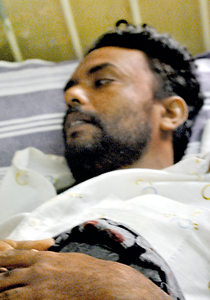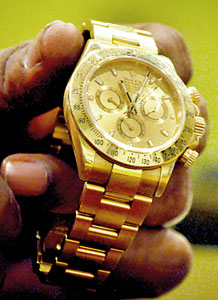News
Museum puzzles and pieces
Museum officials are studying a collection of some 350 gemstones recovered by the Police in order to establish whether any of the stones belong to items stolen from the National Museum during a break-in earlier this year.
Museum superintendent Ranjith Hewage told the Sunday Times that some of the stones may be the same stones that were removed from walking sticks stolen on the night of March 16. “Because the gemstones were recovered along with other museum artifacts, we may assume that these were removed from the walking sticks,” Mr. Hewage said.
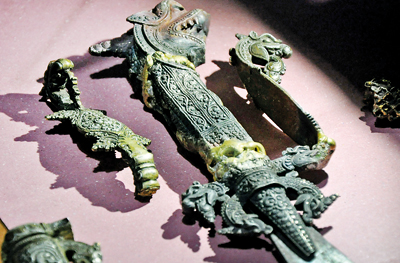
Recovered items (above and below) from March 16 robbery at National Museum. Photos: Mangala Weerasekara
After five months of intense investigations, the Police announced a breakthrough with the arrest of suspect Prasad Niroshan, whose connection with the museum robbery was discovered when Police were investigating an unrelated case of abduction and extortion.
According to Police spokesman SSP Ajith Rohana, seven persons have been arrested in connection with the National Museum robbery case.
Among the recovered items are two large gemstones that could have come from two rings stolen from the museum, Mr. Hewage said. There were also several tiny semi-precious stones, which might have been taken from two walking sticks that were stolen. “There were up to 500 tiny stones on the grips of the sticks, but because of their size the museum will not have records of every single tiny stone,” he said.
A milky-white precious stone adorning the top of the grip is missing. The most important recovery, the museum official said, was a carnelian gemstone with a microscopic carving of a female figure from the first century AD.
“We have only two such stones in the museum collection and there is no doubt that this is one of the missing stones. It is of great historical value,” Mr. Hewage said. “It is easily identified by comparing it with the photographs we have. The stone has been removed from a gold base.”
The other carnelian stone, which has a male figure carved on it, is also mounted on a gold base. “It looks just like a ring. It is a seal or insigne that was used only by the king. Not even a minister could use it.”
The museum also lost eight kastanas, short ceremonial swords unique to Sri Lanka. These swords are made of steel, not gold. There is a kastana blade among the recovered items.
“One of the lost kastanas belonged to the Nugawela Adikaram,” Mr. Hewage said. “We have not ascertained whether this kastana blade is part of the museum collection, but because it was found with other museum items, the chances are it is from the museum.”
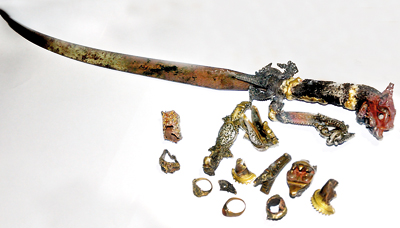 |
 The Museum maintains a database of all its materials, and identifying pieces is only a matter of matching information. |
The handle of a kastana recovered has been confirmed as part of the museum collection. “I have identified two rings with intricate Kandyan carvings,” he said. “One has nine cavities, and from its recorded size and shape I am 100 per cent certain it is one of the stolen items.
Even the very craftsman who turned out these rings would not be able to duplicate them so precisely.”
The museum maintains a database of all museum artifacts, including photographs of every recorded item.
Thirteen currency notes out of 34 issued after Independence by the Central Bank were confirmed as from the museum. “We have matched the numerals on the notes.”
Several coins dating from the time of King Parakramabahu VI, as well as the Dutch and British eras, were confirmed as not being part of the museum collection, he said.
Suspect Prasad Niroshan was arrested by the Colombo Crime Division on a charge of abducting a businessman and demanding a ransom. It was during a search of two houses belonging to the suspect that the Police found what turned out to be some of the missing museum pieces, CCD Director SSP D. R. L. Ranaweera told the Sunday Times. Police found the blade of a sword, a part of the handle of a sword, and two rings.
On Monday, August 20, in a separate detection, the Piliyandala Police recovered the handle of sword, pieces of the handle of walking sticks, pieces of the handles of a sword, and a ring.
A CCD spokesman said markings on the blade of the sword confirmed it was from the museum. The handle of the kastana had been cut into three pieces, suggesting that the thieves were expecting to find hidden valuables inside.
According to the Police, suspect Prasad Niroshan had called his son after his house was searched and instructed him to hide whatever the Police had not confiscated. The son had passed on the remaining stolen items to his girlfriend, who entrusted them to her mother, who in turn left the goods with one of her sisters. The girlfriend, her mother and a three-wheeler driver, were arrested and produced before the Kesbewa Magistrate.
The chief suspect in this case is Lansage Priyantha Mendis, a drug addict who has disappeared from his home in Siyambalape, in Pugoda. Three screwdrivers were found in Mendis’s house. The Police believe the tools were used in the museum break-in.
Police spokeman SSP Ajith Rohna told the Sunday Times that once the main suspect is apprehended, the CID will grill him on the mysterious presence of several luxury vehicles parked close to the Museum on the day of the robbery, March 16.
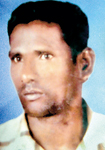 The man believed to have masterminded the robbery. |
The presence of the luxury vehicles was reported to the Police by Stanley Liyanage, a security guard working at the Colombo Art Gallery, which adjoins the Colombo Museum.
On June 17, Mr. Liyanage was abducted and his abductors had threatened to kill him if he did not “confess”to the Police that it was he who had staged the robbery. Mr Liyanage was tortured and held for more than 20 days before being abandoned on a road in Gadaladeniya, close to Kandy, on July 2.
Sunil Wickremesinghe, brother-in-law of Mr. Liyanage and a JVP member of the Udunuwara Pradeshiya Sabha, told the Sunday Times that the CID had not questioned Mr. Liyanage further.
Criminal and strange happenings
The Colombo Museum has been the scene of three incidents that have caught the headlines, says museum keeper Ranjith Hewage.
A couple of years ago, a person believed to be of unsound mind was found sitting on a royal throne used by Sinhala kings. The throne, a gift from a Dutch Governor to King Wimaladharamsuriya II, was last used by the last King of Kandy, Sri Wickrema Rajasinghe.
In 1960, a gem-studded gold crown used by King Rajasinghe the Second, who ruled over the Kandyan Kindom from 1635 to 1687, was stolen. National Museum director K. D. V. Chandimal said only two straps from the crown were recovered.
In 1993, two Buddha statues, several rings and other artifacts went missing. The Buddha statues, belonging to the medieval Polonnaruwa period, have still not been found.
No drug addict could have staged this complex robbery, says Thera
Could a drug addict have masterminded the Colombo Museum robbery, asks Jathika Hela Urumaya leader, the Ven. Omalpe Sobhitha Thera.
“I am only reflecting what the public are saying,” Ven. Sobhitha Thera told the Sunday Times. “Drug addicts are desperate people who act out of impulse. When they feel the need for drugs, they act immediately and take whatever they can lay their hands on. It is hard to imagine such a person behind a robbery that required careful and advance planning.”
The Thera said the longer it takes to get to the bottom of the case, the more the public will speculate. “The Jathika Hela Urumaya held a protest in front of the National Museum, calling on the President to find and punish the offenders,” he said. “I am responsible for what happens in my temple. Likewise, the museum authorities should take responsibility for what happened.”
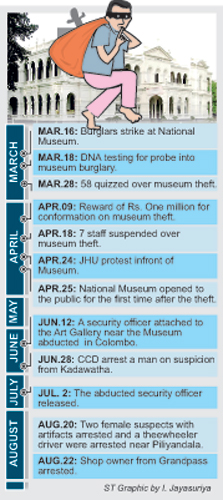 |
Follow @timesonlinelk
comments powered by Disqus
















